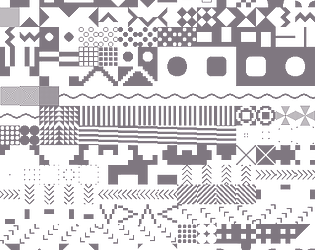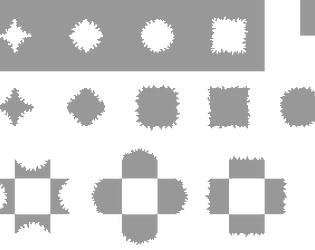Considering the program gives more control over the sprites than most sprite packers, adding the ability to pack multiple images would automatically make your program better than almost every sprite packing tool there is (including ones that range from $15 to $70, no joke). Sprite packers that actually allow control over images are weirdly rare and I don't know why.
Pixelevator
Creator of
Recent community posts
What I want most right now are more tutorials for the engine. I can hardly find anything for DragonRuby that's comprehensive (like all the fundamentals to create a completed game, or a full game code-along that isn't pong or breakout). Things like figuring out top down 8 way movement (without diagonal speed increase) and setting up long quests with dialogue and branching conditionals is very hard and requires brute force manual learning (like RayLib). I was happily reading a tutorial book for the engine made by a user and part way through the writer mentioned 8 way normalized movement and then cheekily left it up to the reader to figure out how to do it, which I was kind of a little really totally angry about. But yeah, more YouTube content would be great if there are users willing to contribute, plus it would help more people to know about the engine. I for one only found out DragonRuby exists because I was scraping through the Tools section of Itch out of sheer curiosity.
I have to be honest, I feel disappointed with the purchase. The main reason I bought this is because of the ability to move sprites on the sheet. I have a ton of tiles that need to be organized on the sheet in certain patterns so I bought the program and loaded up a folder with 192 sprites. I realized soon that attempting to move the sprites around to the correct places resulted in a constant re-arranging of the surrounding sprites, which resulted in a perpetual unmanageable slide puzzle. If moving a sprite to a new location swapped places with that sprite, it would work perfectly. But as it is it's near impossible to arrange my sprites, so I feel like the money was wasted.
Ah, well at least we've had the same ideas! I'll keep using the program and see if anything else pops up into my head in the mean time. Also just in case you want to make it easier to communicate (or if there are any ideas better shared through email) you can get in touch at cory.pelizzari@gmail.com
At the moment my idea is regarding the categories and their elements. As it is there are locked categories (characters, items, concepts etc) which are fine, but the elements you can add to each category are identical. I feel like having particular elements available for their suited categories would help maintain the aesthetic "illusion" of the program if you get what I mean. As it is it kind of feels like a selection of notepads with identical elements (not sure if I'm communicating this properly but the "feel" or "direction" of a program can effect how drawn into its world the end user will feel, basically like a game).
My idea would be to have the category layout as a demo template, then for a blank project, a category can be added and named by the user, who can then assign an icon to it (like the icons already there) from a list. What this would allow is for the user to feel like they are directing the look and feel of their project with provided assets - this would also allow the expansion of more icons in the future (for example an icon for beasts, an icon for traversal etc).
I have other ideas for the elements to be added to each category but for now I'll just throw this one out there.
This is a really promising tool with an attractive interface. If you're open to ideas/requests as you go along I'd be happy to add any info that could help. For example I noticed that you can delete elements added to an info window, but the delete graphic doesn't always stay while the cursor is placed over it, so it took me a while to figure out I could actually delete an element.
I'll explain what lead me to believe this, because the Cocos website is vague.
Upon installing the Cocos dashboard I'm told "to compile native projects you'll need Visual Studio and C++ common tools". From what I know, Visual Studio (as opposed to Visual Studio Code) is what you use when compiling and packaging a program - which I don't like using because I've found it uses up way more of my computers resources and isn't as simple as hitting 'export' in any other game engine and having the engine do the work, which I believe is a common feature in game engines. So, I went to the Cocos site again and looked at the "Cocos Runtime" page, which has a 'contact us' option and no other useful information - this led me to believe that in order to have access to an easier in-engine compiler/exporter, I'd have to pay for it (I can't stress this enough, the website is very vague).
Regarding the resource usage of Cocos itself, I opened up the editor and checked my task manager. It was using from 2500-3000mb of RAM as opposed to 1500mb for Unity, 1300mb for Godot and around 400mb for engines like ct.js, NRG, Fusion 2.5 etc.
I really don't know what else to tell you, apart from this is what I've been led to believe based on what I've seen on the site and what I've experienced with the engine. I'm running on Windows 11 by the way.
One big thing I'd want changed/added is the undo ability. As it is ctrl+z doesn't undo, while clicking the undo button seems to just decrease the opacity of the last pixel placed a few times and then stops working altogether.
I really love this tool but having to select the transparent colour and manually undo is very cumbersome.
The canvas keeps turning into a very small square with no way to enlarge it. I have to make the canvas huge just to be able to see a decent size square on the screen, plus the grid doesn't provide any functionality as it's locked to an arbitrary size. I'm on Windows 11.
I'll wait to see if this can be solved, if not I'm definitely going to want a refund because I can't use the program as intended.
I've noticed it's strong similarity to the old Unity. The only problem is I can't figure out how to use it. Opening up the contents only shows blank pages (I've had this problem with another program's user manual, not sure if it's an issue in Windows 11 at the moment, but RPG Maker's manual is the same and seems to work fine).



